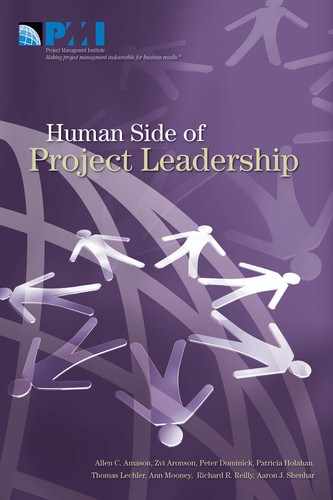CHAPTER 7
Conceptual Background
Great projects create their own unique micro-culture (sometimes called climate), which is nurtured by a set of values that are demonstrated and practiced by the project manager. Culture in project settings refers to the social and cognitive environment, the shared view of reality, and the collective belief and value systems reflected in a consistent pattern of behaviors among project members that we refer to as behavioral expectations or norms. We argue that project cultures can and should be formed to achieve specific and outstanding results. (For other culture definitions, see Detert, Schroeder, and Mauriel 2000; Schein 1992. For a discussion of culture and climate, see Denison 1996. For review on changing culture, see Schein 1990 and Kanter 2000).
Researchers make at least a tacit argument that positive business results will arise from gains in spirit (Giacalone and Jurkiewicz 2003). Scholars provide numerous conceptualizations of what spirit is, variously emphasizing attitudes, emotions, and expected behaviors, detailed below (e.g., Brannick, Salas, and Prince 1997; Cavanagh 2000; Delbecq 2000; Duchon and Ashmos-Plowman 2005; Parboteeach and Cullen 2003). However, by their very nature, projects are temporary, and unlike an existing organization or company, they have a defined beginning and an end. Accordingly, unlike typical team spirit definitions that have focused on various elements such as excitement, group satisfaction, and morale, project spirit should combine all of these components to support the striving for the highest project outcome. Since every project is focused on a specific goal, the project’s spirit should be a manifestation of this goal in terms of attitudes, emotions, and expected behaviors. In this study, we therefore define project spirit as follows: the collective attitudes, emotions, and norms of behavior that are focused on a common vision, which relate to project-expected achievements. The following chapters in this section describe the building blocks or activities that create a project’s spirit and the components that demonstrate the presence of spirit, and use case study results to illustrate these elements in real life projects. We also explore how shaping project spirit alters several paramount behaviors of participants in project settings.
Based on the literature, we identified four groups of spirit building activities: vision, values, team events and rituals, and symbols. Our premise is that spirit building blocks can be managed: managers can articulate a specific vision; instill the right values; initiate team events and rituals; build specific symbols; and align them with the project goal to shape project spirit. We also identified three groups of spirit expression components: attitudes, emotions, and norms of behavior (see Figure 7-1). Chapters 8 and 9 discuss these components in detail.

